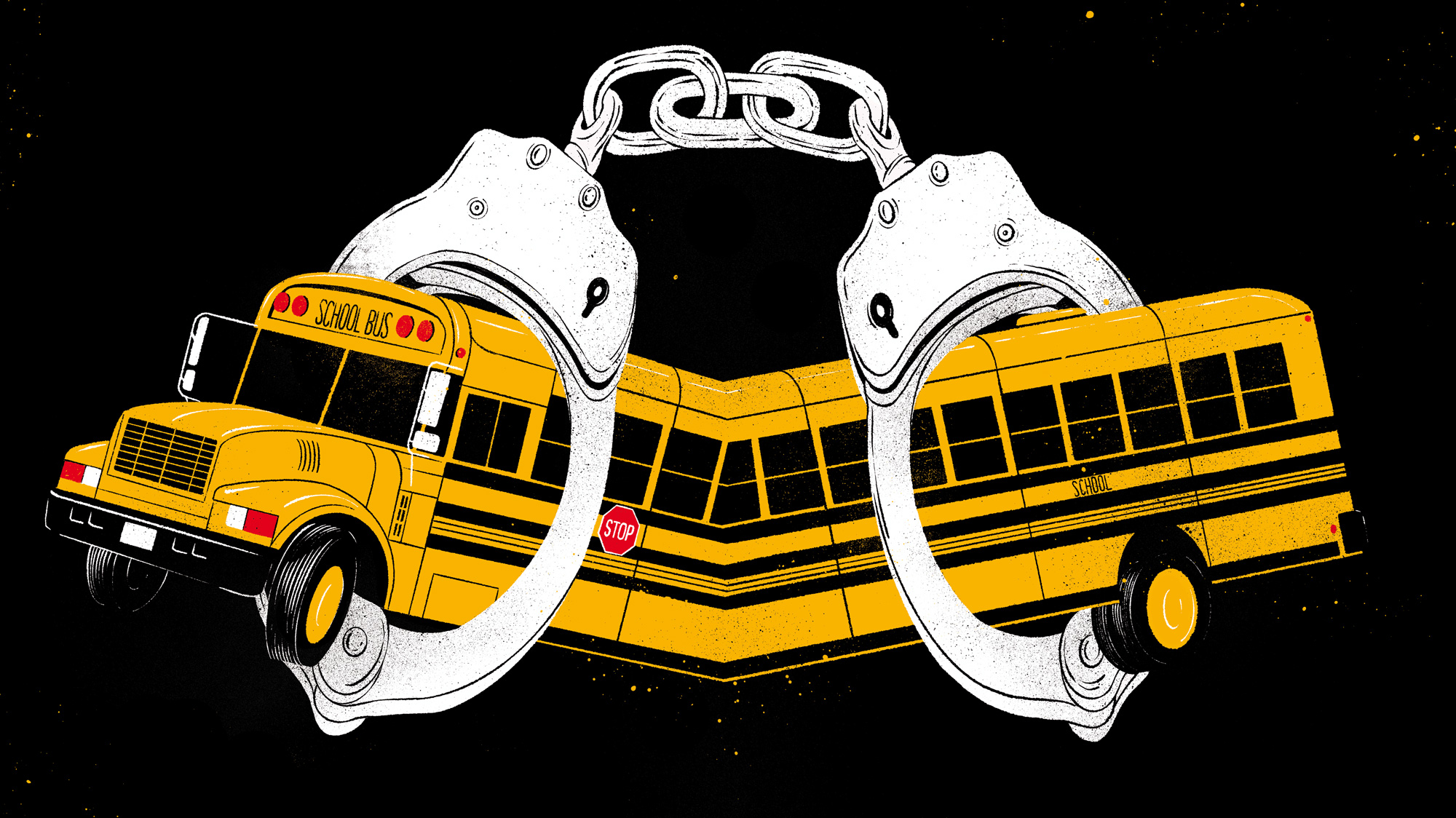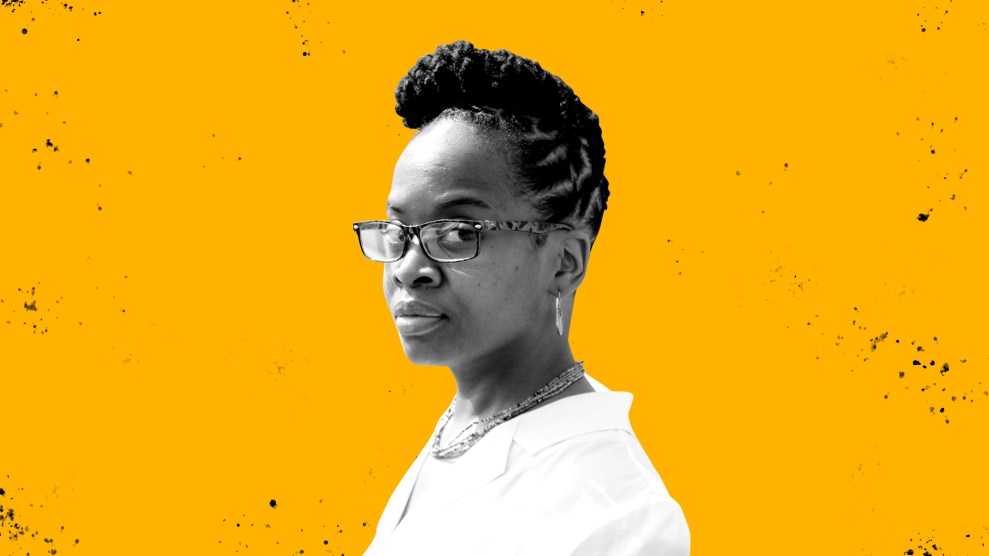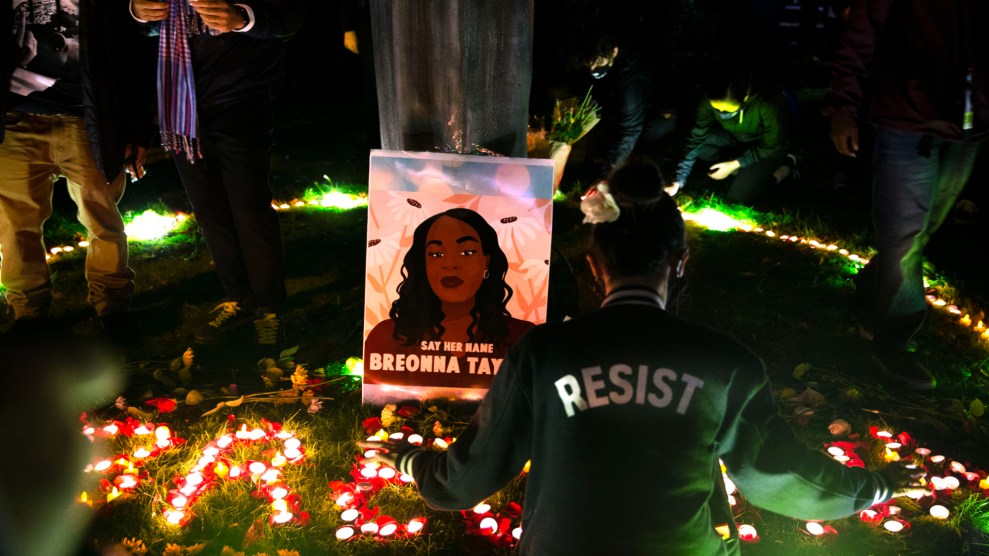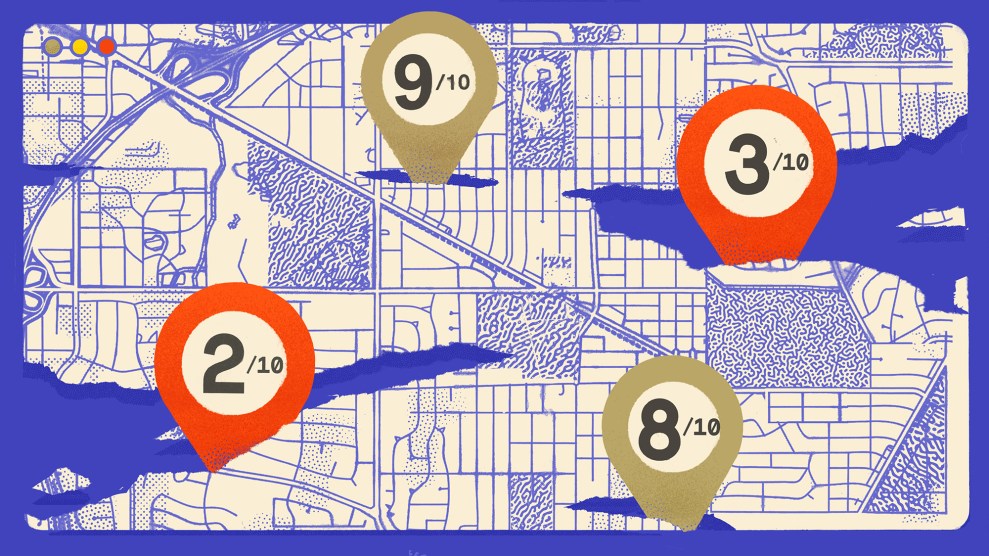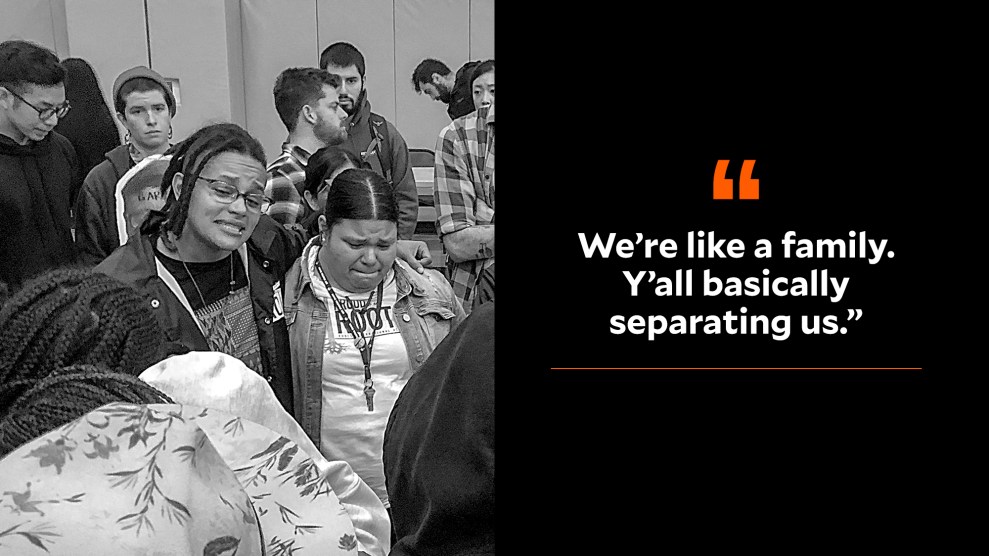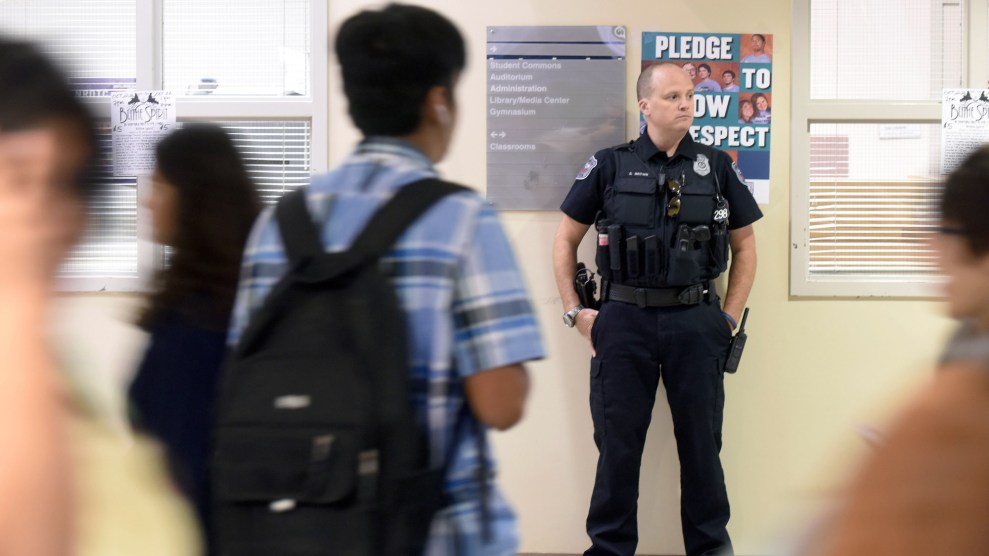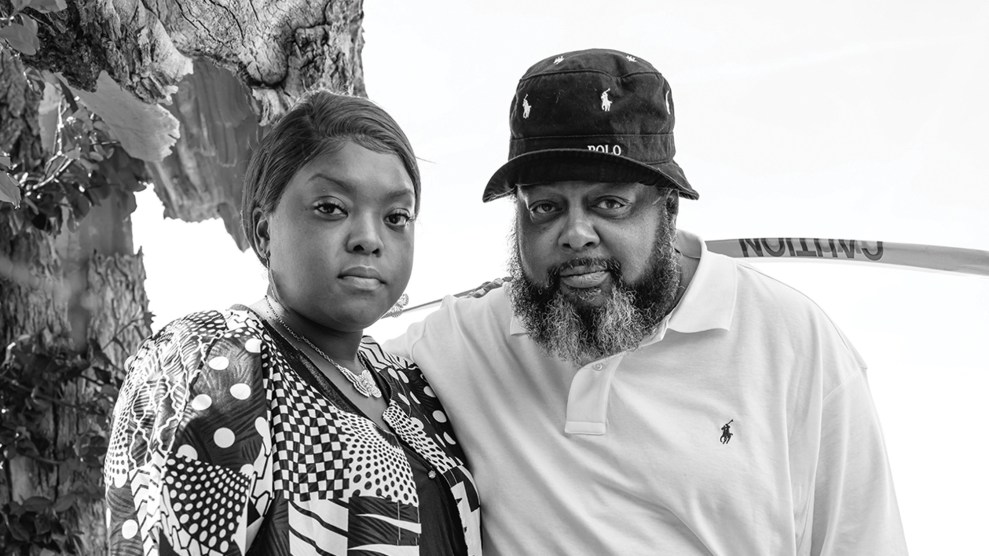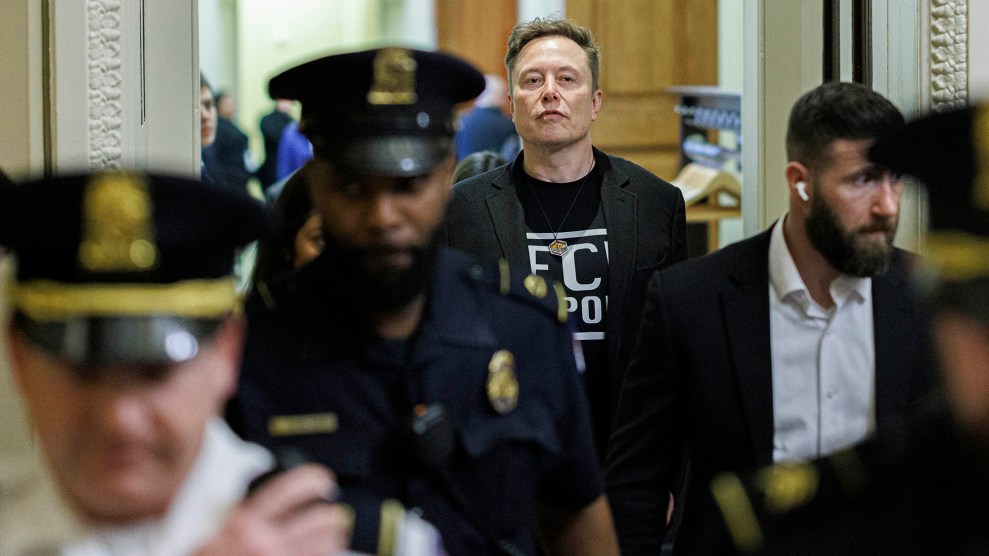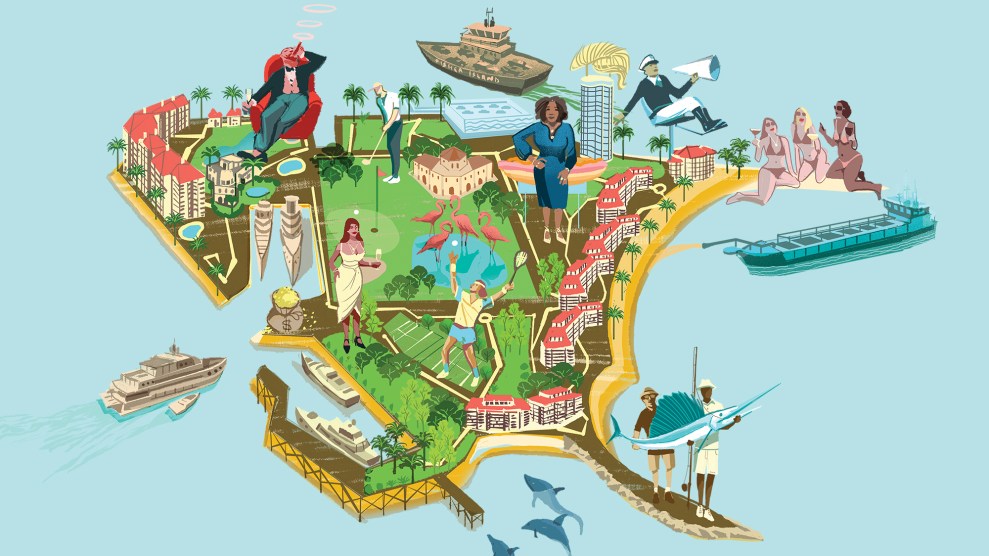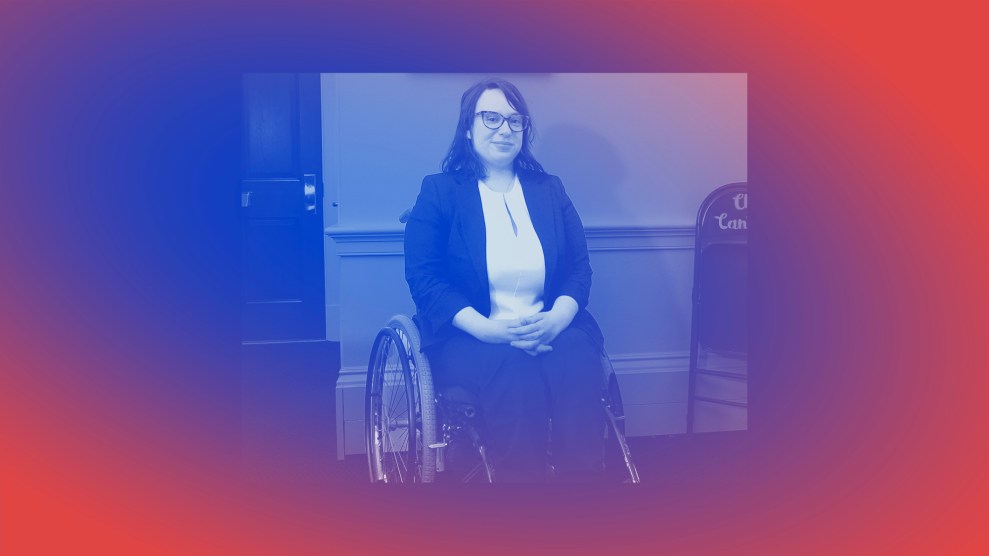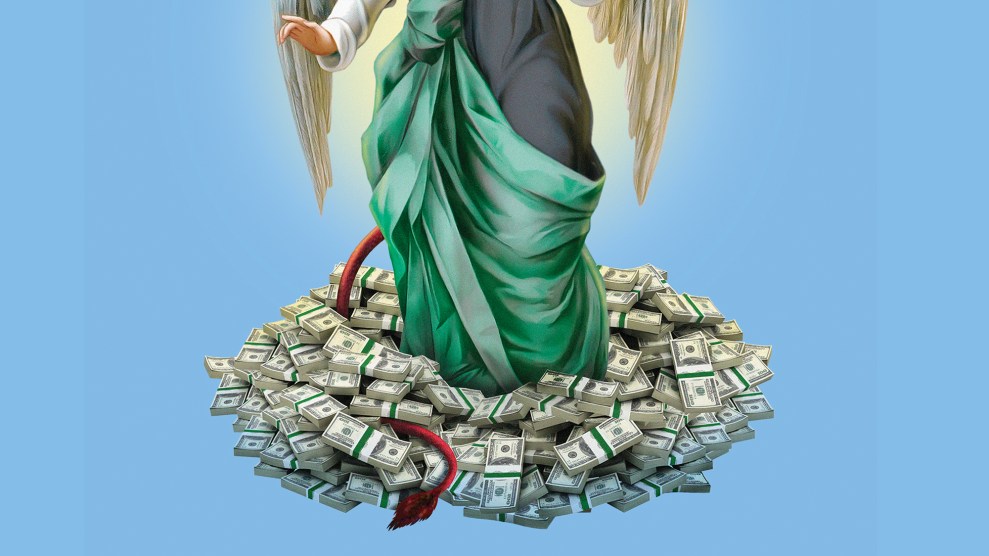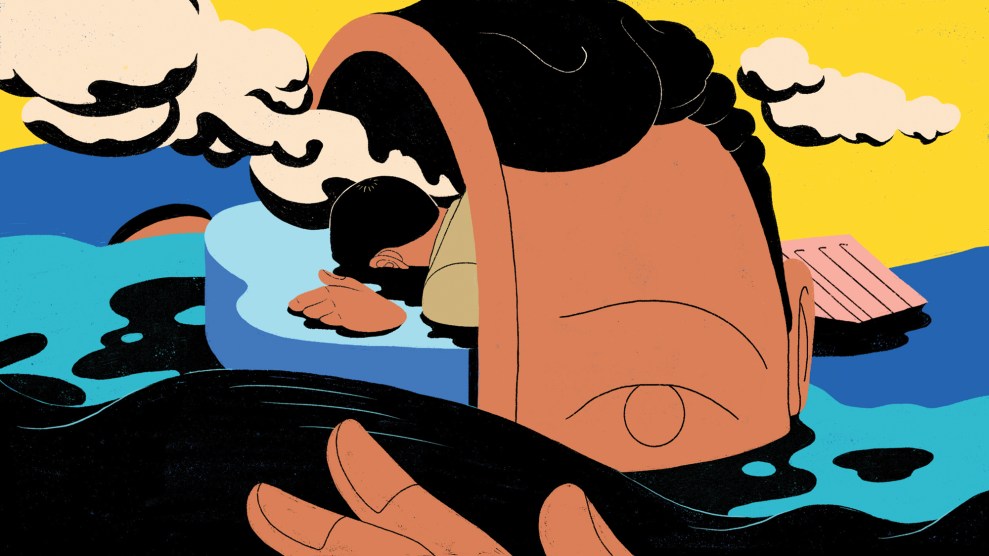One winter night in Oakland nine years before a police officer knelt on George Floyd’s neck, Raheim Brown and his friend Timesha Stewart, both 20, were smoking weed in a Honda, hazard lights blinking. It was 9 p.m., and two cops who had been patrolling a school dance near Skyline High School approached the car. They were Barhin Bhatt and his partner, Jonathan Bellusa, both sergeants with the Oakland School Police Department. At the time they did not know the Honda had been stolen. They would claim they decided to investigate because they thought the car was parked in a strange spot.
Pretty much everything that happened next is still in dispute. Bhatt walked up to the driver’s side, where Stewart was seated, and began speaking to her. Brown told her to drive away, reaching over and jamming a screwdriver into the ignition. Bellusa opened the passenger door and grabbed Brown by the collar to stop him. When Brown resisted, a violent struggle ensued. Bellusa believed Brown was stabbing him in the upper chest, though Stewart insists the screwdriver never left the ignition, and a forensic analysis found no strike marks on Bellusa’s shirt or vest.
“Shoot!” Bellusa yelled. He says he spotted a revolver in the passenger door, though Stewart insists there was never a gun in the car and that the one found by police had been planted after the fact. “Gun!” Bellusa shouted. Bhatt shot Brown seven times. Stewart would later recall her friend’s plea: “Help me, sis.” He passed away in that passenger seat, his hands resting on his lap.
Brown’s family demonstrated in front of Oakland Unified School District headquarters with dozens of people, calling for the disbanding of the city’s school police force. Brown’s mother, Lori Davis, described her son as a “very beautiful, loving, bright, intelligent, respectful human being.” She called his killing an “assassination.” She and Raheim’s father sued the district and eventually received a settlement, but no reforms were made to the Oakland School Police Department.
A former police lieutenant hired by the school district to conduct an investigation found that Bhatt had been “in reasonable fear” and was thus “justified in shooting Brown.” Bellusa later alleged that the school district tried to cover up the incident. Nevertheless, Bhatt was promoted to interim school police chief just months after Brown’s death; the previous chief, Peter Sarna, had resigned after he told a Black police sergeant during a drunken exchange that “the only good nigger is a dead nigger and they should hang you in the town square to prevent any other niggers from coming in the area.” Bhatt lasted just one month. He now runs a private security firm.
How Brown died had everything to do with where he died. Skyline High, up in the Oakland hills, had been the site of a bitter fight over segregation. Not coincidentally, the Oakland School Police Department was created in 1957, the year after the school’s construction was approved. If you want to understand why there were cops patrolling school dances in 2011, you have to go back more than 50 years, to the migration of Black Southerners into the city, into its shipyard jobs and Victorian houses and classrooms, and to the racist backlash of white Oaklanders against it. Cops and schools and segregation—in Oakland, as in other urban centers, the evolution of these institutions is intertwined. Just look at the numbers from recent years. Since the 2015–2016 school year, Black students have accounted for nearly three out of four arrests at Oakland schools, despite constituting 26 percent of students. From 2010 to 2012, not a single white student was arrested by Oakland School Police.
As of this summer, the police force that killed Raheim Brown no longer exists. In June, the Oakland school board approved a resolution named for George Floyd that would abolish its school police department altogether. Since Floyd’s death, at least 40 other school districts around the country have significantly reduced their use of “school resource officers”—a euphemism for cops in schools—or outright eliminated them, according to the Justice Policy Institute.
In Oakland, the victory was roughly half a century in the making. For as long as cops have been in the city’s school system, Black Oaklanders have protested their presence. The history of their resistance reveals a deeper meaning to the June resolution. It wasn’t just a matter of getting the police out of the schools. It was part of the unfinished project of rolling back the color line.

Delinquency had to be invented before delinquents could exist. In 1852, amid a massive wave of Irish immigration, Massachusetts passed the country’s first compulsory education law. “Aimed at youth who were not in school or gainfully employed, whom the law defined as truants, it permitted the police to scoop them up from the hurly-burly of Boston street life and its temptations of vice and crime,” writes Annette Fuentes in her book Lockdown High. “Almost an early version of current day racial profiling in law enforcement, this law targeted Irish children, who, along with their mostly impoverished families, were seen as contributing to social disorder and crime.”
The dynamic is no great mystery: A new underclass must be criminalized to justify its subordination. For children, sociologist Frank Tannenbaum observed in 1938, this meant labeling normal acts of “play, adventure…mischief, fun” as delinquent. Tannenbaum viewed early contact with authorities as a critical part of what he called “the dramatization of evil,” whereby “the young delinquent becomes bad because he is defined as bad and because he is not believed if he is good.”
It was another vast movement of people, the Second Great Migration, that led to the modern explosion of school policing. Beginning in the 1940s, Black people fled the South in huge numbers for industrial centers in the North and West—cities like Chicago, Detroit, Los Angeles, and Oakland. In 1940, Black residents accounted for just 3 percent of Oakland’s population. A decade later, they made up 12 percent.
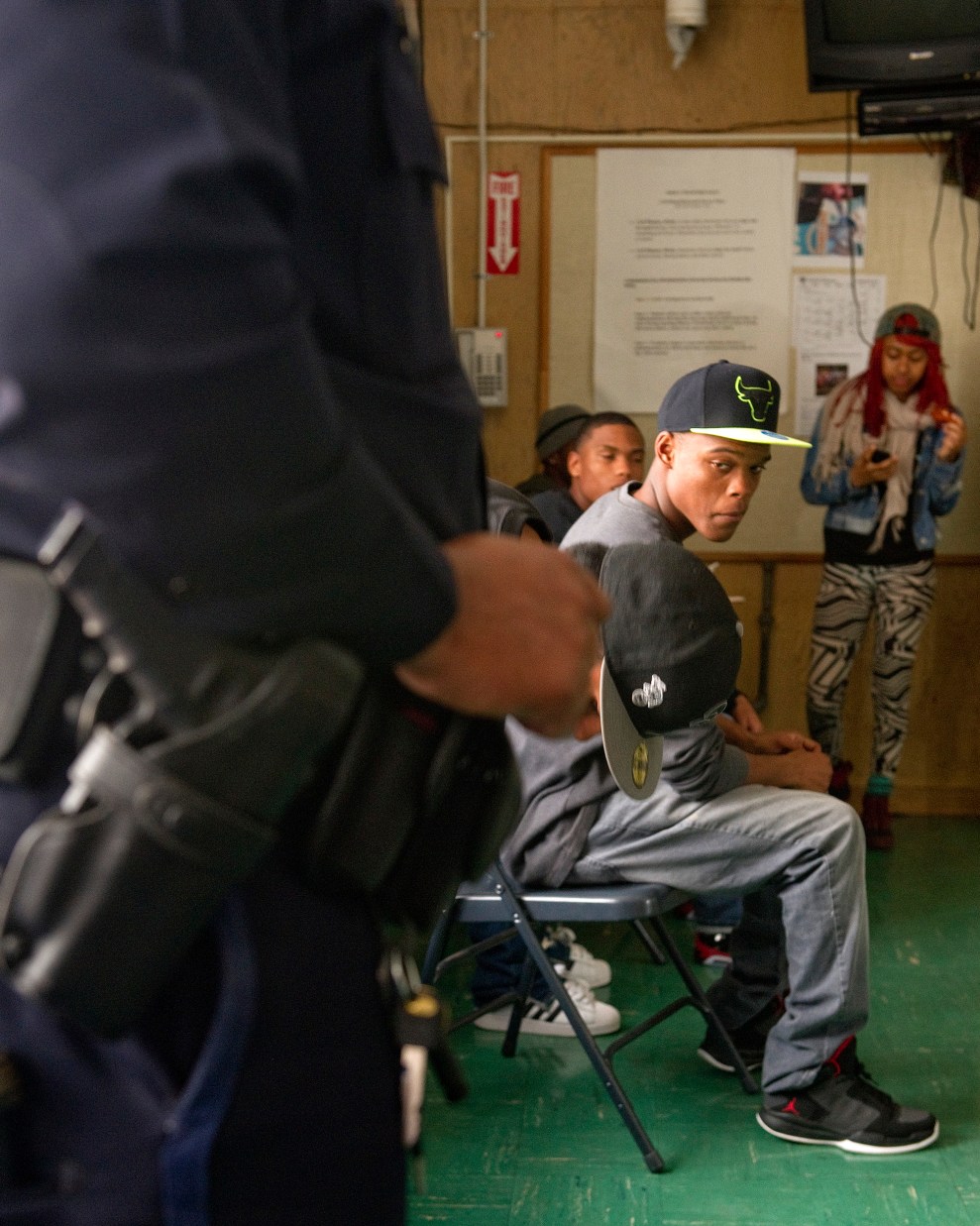
An Oakland police officer addresses students in a restorative justice class at Ralph Bunche High School in 2013.
Ann Hermes/The Christian Science Monitor/Getty
“The response to this mass migration of African Americans into California was a punitive one,” said Donna Murch, a history professor at Rutgers University and the author of Living for the City: Migration, Education, and the Rise of the Black Panther Party in Oakland, California. “From the point of view of Black migrants, they see California as a place of opportunity. The schools and the police, these different parts of the state, see them as a threat.” School policing was part of a general program of social control, intimately connected with other practices developed in rapidly integrating cities to maintain Jim Crow by another name. Black people were redlined out of access to mortgages, and Black families were gerrymandered into underfunded school districts whose schools tended to be microcosms of the system of racial subordination. Black students were “tracked” into low-achievement classes, surveilled by administrators, and criminalized by the police. “When you don’t provide resources, and you don’t set expectations, and you essentially tell people at a very young age that they are limited, you actually are producing those limitations,” Murch said. “The problem is white supremacy and racial violence. The police are a literal, physical form of violence, but you have these other forms of violence, through that denial of an education for your future, through stripping children of their sense of themselves to telling a generation of children that they are stupid.” These processes are fundamental to the workings of white supremacy and anti-Blackness. “Black children are never allowed to be children,” Murch said.
In post–World War II Oakland and elsewhere, a newly arrived underclass was being defined and kept in its place, often at the point of a cop’s baton. “They’re producing a social reality,” Murch said, “and then in turn criminalizing it.” In Los Angeles, the school district started its own quasi–police force in 1948, with security guards protecting school property. A few years later, Flint, Michigan, started the nation’s first school resource officer program.
In 1956, Oakland’s school board approved a bond to build a school on a 35-acre plot in the city’s hills: Skyline High. The school, which was finished in 1961 at a cost of nearly $5 million, was meant to reduce overcrowding at predominantly Black high schools. When the school board drew Skyline’s attendance boundaries, Black parents charged that they amounted to gerrymandering to keep their kids out. Oakland’s NAACP chapter president said that Skyline had “all the trapping of a private prep school after we were assured it would be just like any other high school.” The clash happened at a time when local officials had “consistently allocated resources to segregated white schools in wealthy areas of the city while neglecting overcrowded schools” in Oakland’s flatlands, according to Murch.
With the color line came the cops. Oakland’s school police force started as a small group of uniformed security guards—unarmed at first, though that would soon change—who went through city police department training and patrolled schools on nights and weekends to stop burglaries and defacement of school property, and to “keep youngsters from dangerous play areas,” as the Oakland Tribune put it.
The force’s creation formalized the existing security presence in Oakland’s schools. Even before the school police department came along, “you had police presence at school dances,” Murch said. “You had contacts between school administrators and the police where they were trying to identify troublemakers.”
Some of those so-called troublemakers would go on to shape activism in Oakland for generations to come.
“During those long years in the Oakland public schools, I did not have one teacher who taught me anything relevant to my own life or experience,” Huey Newton, co-founder of the Black Panthers and 1959 graduate of Oakland Technical High School, writes in his autobiography, Revolutionary Suicide. The book describes how the Black Power movement grew out of Black migrants’ encounters with the stewards of the color line. (Newton moved with his family to Oakland from Louisiana in 1945.) His experiences in Oakland’s classrooms and the California Youth Authority influenced his political thought and later informed his activism at Oakland City College (now called Merritt College). “We went to school and we got kicked out,” Newton wrote. “We drifted into patterns of petty delinquency. We were not necessarily criminally inclined, but we were angry.”
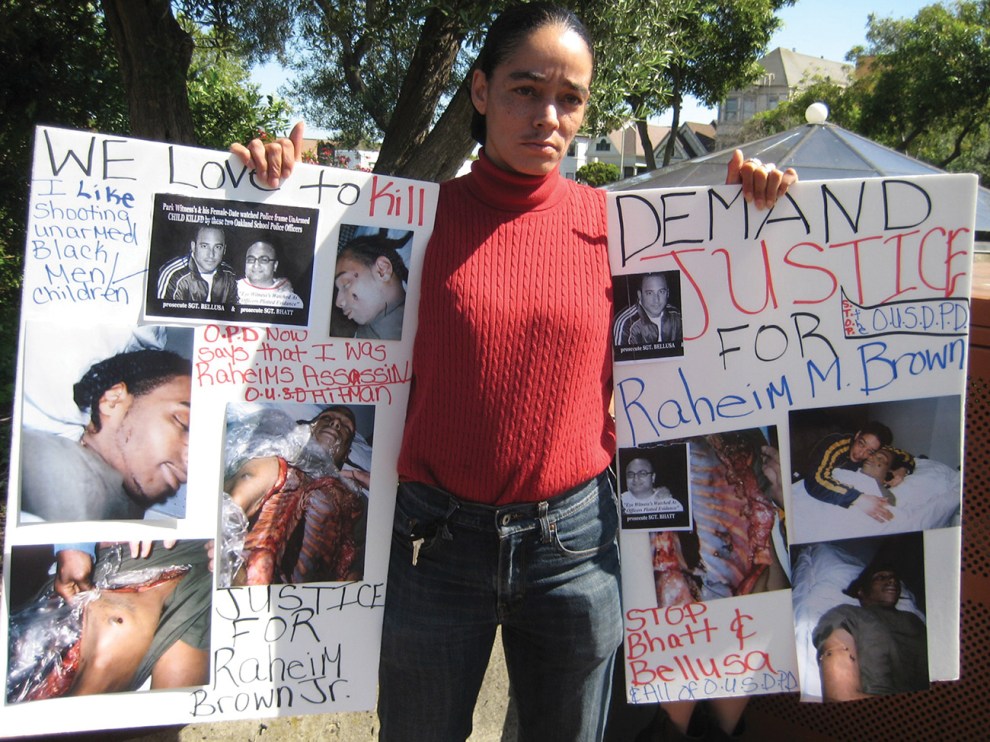
Lori Davis, the mother of Raheim Brown, holds up autopsy photos at a rally in 2011.
Rebecca Ruiz/Anti Police-Terror Project
Newton had undergone Tannenbaum’s “dramatization of evil.” He was a delinquent. This wasn’t a failure of a segregated school system; it was the goal. Historian Heather Ann Thompson writes of the “criminalization of urban space” in the postwar period, “a process by which increasing numbers of urban dwellers—overwhelmingly men and women of color—became subject to a growing number of laws that not only regulated bodies and communities in thoroughly new ways but also subjected violators to unprecedented time behind bars.” This was the 20th century’s answer to the criminalization of rural Black spaces in the aftermath of the Civil War, when the “Black Codes” proliferated throughout the South, prosecuting newly freed people for minor offenses and leading to the mass imprisonment of Black men. The moral panic over “juvenile delinquency” in urban schools was central to the process Thompson describes. Officers installed in schools didn’t police crime so much as produce criminality.
The authoritarianism of majority-Black high schools in the early 1960s put Black students in an impossible bind. They were seen as compliant dullards if they remained silent, and they were agents of disorder if they protested the inequities under which they were forced to learn. The Black Power movement spread to schools, leading to crackdowns. In November 1967, 3,500 students protested outside a school administration building in Philadelphia. “Inspired by local civil rights and Black Power activists, the students demanded more black teachers, the inclusion of African American history to the curriculum, and permission to celebrate their African heritage by wearing traditional clothing,” historian Timothy Lombardo writes in Blue-Collar Conservatism. School officials tried to negotiate a settlement, but the city’s police commissioner, Frank Rizzo, a notorious racist who would later become mayor, ordered cops to stamp out the demonstration.
“Rizzo and his blue-collar supporters, however, said the school board protest was evidence of the breakdown of law and order in the schools,” Lombardo writes. “Blue-collar whites believed Rizzo had defended the public schools from the demands of Black Power activists.” The balance of history’s judgment seems to have shifted in the students’ favor. Local students recently secured a commemoration of the 1967 walkouts, and in June Philadelphia officials removed a bronze statue of Rizzo. Today, the Philadelphia Student Union, a youth organizing group, is calling for the removal of police from schools.
In 1968, during four days of unrest over racism in local schools, “black militant students”—as the Oakland Tribune labeled them—at Fremont High School demanded the ouster of certain white staffers, the formation of a Black student union, the hiring of Black teachers, and the inclusion of Black history in the school curriculum. The students clashed with police after an assembly with the principal to discuss their demands. As Fremont planned to reopen, Black students complained about the police presence at the school, claiming officers had called them “niggers” and “had been rough with them,” according to the Tribune. At a public meeting, officers said that Black students had “harassed” them. A white mother added that she would be reluctant to send her child back to school without police protection.
“Every time there was any kind of disruption in the schools on behalf of civil rights or any tensions, Black and Brown kids always got the brunt,” Thompson told me. “Policing was there for them.” That early resistance to school policing created a fear of Black and Brown power in schools, which resulted in more surveillance of students. Oakland hired its first “juvenile control coordinator” to keep tabs on students who’d come into contact with the probation department, health and welfare agencies, and the cops.
Meanwhile, as the ACLU noted in a 2017 report, Oakland police would “track students whom school administrators deemed delinquent, detaining young students irrespective of whether or not a crime was reported.”
In a 1973 issue of the Black Panther Intercommunal News Service, an article titled “Will Police Patrol Oakland Schools?” describes an “ominous” effort by administrators to reduce “admittedly high rates of truancy, vandalism, and violence” by sending an “onslaught of police and police-types” to junior and senior high schools. The district had applied for a $1.5 million grant from the California Council on Criminal Justice to implement the Coordinated Interagency Action Program for the Reduction of Truancy, Vandalism, and Violence in Select Urban Schools—an effort the Panthers referred to as “CIA.”
“Nowhere is there the mention that improved facilities, improved teaching methods, concerned teachers, and subject matter that relates to the students’ experience and life style would solve the problem,” the article notes. Marcus Foster, the city’s first Black school superintendent, tried to walk a reformist path between police supporters and the Panthers. He called for police-trained “peace officers” and “safety coordinators,” a truancy coordinator, more coordination between the police department and juvenile court system, and a student ID program, but he also adamantly opposed any permanent police presence in schools. In November 1973, members of the Symbionese Liberation Army assassinated Foster with cyanide-laced bullets for his role in creating a “Special Political Police Force” to “occupy and patrol the schools in our cities.” Foster’s death “killed any momentum to stop policing in schools,” Manuel Criollo, an activist who has studied the history of school policing in Los Angeles and Oakland, told the Oaklandside.
In 1974, Congress passed the Juvenile Justice and Delinquency Prevention Act. As a result, schools serving “economically and educationally disadvantaged children” encountered “widespread police patrol,” Yale historian Elizabeth Hinton writes in her book From the War on Poverty to the War on Crime: The Making of Mass Incarceration in America. “Even as federal delinquency programs and the growing school security industry created an environment where urban schools were increasingly guarded like prisons, schools nationwide were safer in the 1970s than they were in the 1960s.”

A 1985 police brutality protest in Oakland.
Smith Collection/Gado/Getty
The juvenile delinquency legislation effectively established a fractured system that, she adds, “criminalized black children and teenagers and decriminalized white youth.” The law designated an underclass of kids living in poor communities as “potentially delinquent”—a label that stuck before they committed a violation. “The youth crime control apparatus was the lynchpin of the mass incarceration of black and Latino citizens,” Hinton writes. The presence of law enforcement in schools escalated during America’s mass incarceration era. A 1976 study showed that only 1 percent of the nation’s schools had cops stationed in them. By 2016, nearly half of all schools and 65 percent of secondary schools had police patrolling their halls at least once a week.
A drug war was on, and fears about crime and violence reached a hysterical pitch. In 1982, California voters passed a sweeping crime package known as the Victims’ Bill of Rights. It established an “inalienable right” for students and school staff “to attend campuses which are safe, secure, and peaceful.” Dozens of lawsuits were filed against school districts by parents, the Pacific Legal Foundation, and the Reagan-affiliated National Center for School Safety, alleging a failure to ensure safe environments.
Police recruits infiltrated schools posing as high schoolers to conduct drug busts. TV shows like 21 Jump Street celebrated police presence in schools. In 1993, New York Mayor-elect Rudy Giuliani called for putting a cop in every violent school, describing a hellscape of confiscated weapons, “harmed” teachers, and “murdered” children. On this point there was bipartisan consensus. The man he unseated, David Dinkins, the first Black mayor of New York City, had said much the same thing, and soon enough Hillary Clinton was speaking of “superpredator” teenagers who needed to be brought “to heel”—just as arrests of kids for violent crimes were starting to decline.
Policing in schools was a one-way ratchet. The Violent Crime Control and Law Enforcement Act of 1994 allotted $9 billion toward putting more police officers on the streets and in the schools as a form of “prevention.” In 1998 and then again the following year, after the mass shootings at Columbine High School, President Bill Clinton noted that those additional funds would combat “school crime, drug use, and discipline problems.” In fiscal years 1998 and 1999, the Community Oriented Policing Services program granted more than $30 million for law enforcement in 275 areas to “partner with school entities to address crime and disorder in and around schools.”
“It just shifted the culture so much more,” Thompson said. “It translates into a hyperpolicing of schools and neighborhoods in communities of color that really take the incarceration and detention numbers up through the roof.”
Dan Siegel, a civil rights attorney who worked for the Oakland school district as general counsel, saw an evolution in school policing during his time on the board from 1998 to 2006. It went from what Siegel viewed as a “pro-child policing force” to what many Oaklanders saw as “an occupying force” that was “much more armed and prone to racial profiling.” OUSD police officers operated out of a former school building, organized under nearly identical standards as regular police departments, and lacked “any special guidelines or criteria for working with youth or interacting with schools or policing in a school setting,” according to a 2013 analysis of school police policies conducted by the Black Organizing Project, an Oakland-based community organization.
As discontent exploded in American cities after the killing of Michael Brown in Ferguson, Missouri, in 2014, civil rights groups demanded that the Defense Department stop sending excess military equipment like rifles and armored vehicles to school police, noting it “can only exacerbate existing tensions, intensifying overly punitive atmospheres that criminalize and stigmatize students of color.” A 2013 Congressional Research Service report noted that schools with law enforcement officers have a higher incidence of students getting arrested for minor infractions, effectively pushing students into the criminal justice system for misbehavior. A Justice Department-funded study published this summer found that increasing school resource officers “does not improve school safety” and instead “increased the number of drug- and weapon-related offenses and exclusionary disciplinary actions for treatment schools relative to comparison schools.” The study’s authors concluded that school officials “would be wise to consider the many alternatives” to ubiquitous school policing.

The Oakland School Police Department died by Zoom conference call. The June 24 decision was as awkward as it was momentous—full of technical difficulties and apparently passionate commentary from people who’d failed to unmute themselves. The folks who could be heard sounded the same notes Oaklanders have been hitting for more than 50 years.
“What do you think our Black and Brown kids think when school officials call the police on them in a place where they’re supposed to feel safe?” one parent asked the board. “How are police going to help us become better leaders?” a high school freshman said. “They shouldn’t be in our schools.” A third grader asked why the district paid for police but didn’t invest in making schools beautiful. It wasn’t the police who protected her, she said. It was her teachers.
“I hope this board stands on the right side of history,” said Denilson Garibo, an Oakland High School graduate and student board representative, wearing a white shirt with the letters B.O.S.S. on his chest. It stood for “Bettering Our School System,” the campaign that the Black Organizing Project had launched nine years earlier in hopes of reaching this moment. The group’s executive director, Jackie Byers, stood by Garibo and looked on. “Instead of cutting police, y’all keep cutting assistant principals, restorative justice, and all of these needs that keep youth of color on the right path,” he said.
The board’s vote that night to dissolve the Oakland School Police Department was unanimous.
The climate in which Oakland eliminated its school cops was very different from the one in which the city had created it. Since Floyd’s killing, cities across the country had begun to uncouple policing from education. Minneapolis’ school board voted on June 2 to cut ties with its police department. Two days later, Portland’s superintendent made a similar announcement. And on June 30, under pressure from student activists, Los Angeles’ school board approved cutting $25 million from its police force, prompting its chief’s resignation.
But it was the work done in the wake of Raheim Brown’s killing, by the Black Organizing Project and other activists, that had catalyzed a half-century’s worth of discontent with cops in Oakland’s schools. In 2011, two years before the creation of Black Lives Matter, Byers helped launch BOP to fill what she and her partners saw as a void in Black-led organizing focused on Black people’s needs. “We didn’t have a specific issue,” Byers told me. “We wanted to build community and we wanted to let the community determine what they wanted to work on.” After Brown was shot, their broad mandate sharpened into focus.
As Brown’s mother was “pleading for answers from the district,” Byers says, BOP promised that cops would be abolished from Oakland’s schools by 2020. They pushed for the district to require the collection of data on incidents on campuses and advocated for limiting the circumstances in which school administrators could call police. Effectively what they were doing was reversing Tannenbaum’s “dramatization of evil” formulation. People had to be made to see the evil of dramatization—the demeaning process of “tagging, defining, identifying, segregating, describing, emphasizing” to which Black and Brown youths are routinely subjected and to which Raheim Brown was sacrificed.
They succeeded, and now it was up to the district and community to figure out what an alternative would look like. The Black Organizing Project envisioned a police-free school district emphasizing “peace-keeping, culture-keeping, and restorative justice” practices. They hoped “peacekeepers” would operate under the district’s umbrella and focus on deescalation. The district would direct money cut from the police toward counselors and restorative justice practitioners. The resolution left open the prospect of calling Oakland’s police force in cases of emergency at a school. Byers wanted to change the paradigm of bringing in the cops to address minor problems, which she sees as the equivalent of “calling the fire department for burnt toast.”
Two months later, when school board members reconvened to discuss the resolution, the district had yet to devise a plan for a police-free future, but Superintendent Kyla Johnson-Trammell hoped that a plan would be finalized in December. “The relationship with the community and district is one of mistrust,” Jessica Black, BOP’s organizing director, told the board. That mistrust is a product of the historically fraught relationship with police, constant budget cuts, school closures, and a recent teachers strike. “Oakland can be a model for police-free schools for our entire country,” she said, “and because of historic mistrust, show a new model for how school districts can work collaboratively with the community.”
That’s the whole story of the city, in Murch’s eyes. When she wrote Living for the City, Murch was living in Oakland. She saw the book as a love letter to the city, to the way it had created a universal grammar for resisting the police and other forms of racist social control. She remembers giving a talk in Ireland once, and they called the cops “pigs” there, too, a touch of radical Oakland echoing back to her. And now, perhaps, the city would be a model once more. “Oakland’s most important legacy is not the police,” she said. “It’s the fight against the police.”

